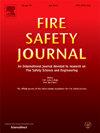Susceptibility to ignition of landscaping mulches exposed to firebrand piles or radiation
IF 3.4
3区 工程技术
Q2 ENGINEERING, CIVIL
引用次数: 0
Abstract
Mulch products are widely used in landscaping at the wildland-urban interface (WUI), but burning mulch poses a significant ignition hazard to nearby structures. This study evaluates the ignition susceptibility of 10 mulches used in California, USA, exposed to smoldering firebrand piles or irradiation. The mulches included composted types, where products are piled and partially decomposed (bioretention, cal trans, marin vineyard, topper mulch, screened compost) and non-composted types (forest floor, redwood, black mulch, fir bark A and B). We found that all mulches except screened compost can be ignited to smolder by firebrand piles, with ignition more likely at higher firebrand mass and wind speeds. Following spotting ignition, non-composted mulches were more prone to transition from smoldering to flaming at critical wind speeds, which varied by mulch type. For piloted ignition, all mulches can sustain flames under irradiation, with non-composted mulches generally requiring lower critical heat fluxes due to the emission of more combustible gases. Particle size significantly influenced ignition thresholds, with smaller particles facilitating piloted flaming ignition and larger particles being more susceptible to spotting ignition and smoldering-to-flaming transition. This work deepens our understanding of ignition and burning behaviors of mulch, helping improve the prevention and suppression strategies against catastrophic WUI fires.

暴露在火把桩或辐射下的园林绿化覆盖物易着火
地膜产品被广泛应用于荒地-城市界面(WUI)的景观美化中,但燃烧地膜会对附近的建筑物造成严重的着火危险。本研究评估了在美国加利福尼亚州使用的10种地膜暴露于阴燃的火把堆或辐照下的着火易感性。地膜包括堆肥类型,其中产品堆放并部分分解(生物保留,cal trans, marin vineyard,顶部地膜,筛选堆肥)和非堆肥类型(森林地面,红木,黑色地膜,杉木树皮A和B)。我们发现,除了筛选堆肥外,所有地膜都可以被火焰堆点燃以闷烧,在更高的火焰质量和风速下更有可能着火。在发现点火后,非堆肥地膜更容易在临界风速下从阴燃过渡到燃烧,这因地膜类型而异。对于引燃,所有覆盖物都可以在照射下维持火焰,而非堆肥覆盖物由于排放更多可燃气体,通常需要较低的临界热通量。颗粒大小对点火阈值有显著影响,较小的颗粒有利于引燃点火,较大的颗粒更容易发生点燃和阴燃过渡。这项工作加深了我们对覆盖物着火和燃烧行为的理解,有助于改进对灾难性WUI火灾的预防和抑制策略。
本文章由计算机程序翻译,如有差异,请以英文原文为准。
求助全文
约1分钟内获得全文
求助全文
来源期刊

Fire Safety Journal
工程技术-材料科学:综合
CiteScore
5.70
自引率
9.70%
发文量
153
审稿时长
60 days
期刊介绍:
Fire Safety Journal is the leading publication dealing with all aspects of fire safety engineering. Its scope is purposefully wide, as it is deemed important to encourage papers from all sources within this multidisciplinary subject, thus providing a forum for its further development as a distinct engineering discipline. This is an essential step towards gaining a status equal to that enjoyed by the other engineering disciplines.
 求助内容:
求助内容: 应助结果提醒方式:
应助结果提醒方式:


